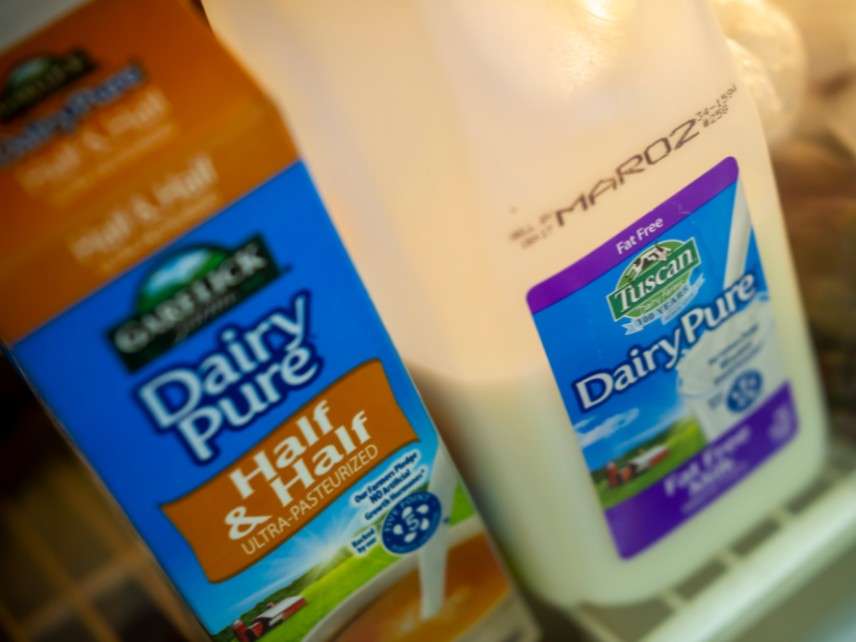Thanks to Decades of Government Meddling, U.S. Dairy Is Going Through a Crisis
It's time to let the free market dictate dairy production.

This week Dean Foods, the nation's largest dairy, reported steep quarterly losses. The Wall Street Journal notes the company is trying to sell its "struggling business" even as its share price sinks and the company cancels contracts with dairy farmers thanks to poor demand and a glut of dairy products.
It's not just Dean Foods that's listing. Dairy farmers around the country are in the same leaky boat. Many people agree that dairy farming in America has reached a crisis stage. How'd it get there?
The downturn in milk prices began after record highs in 2014. They've spiraled since. Milk prices are now at their lowest point in 50 years.
As Civil Eats reported last year, dairy farmers are losing money on every sale. "Many of them have been forced to shutter their operations due to a milk glut and its attendant low prices—as of this writing, $16.33 per hundredweight (in layperson's terms, about 11.5 gallons), considerably less than the $22 it costs to produce."
The number of dairy herds in Wisconsin has fallen by half in just 15 years. A staggering 700 dairy farms in the state closed just last year. Similarly dire data has emerged in New York, California, Ohio, and Vermont.
Overall, dairy consumption (including fluid milk, cheese, and butter) has plummeted over the past four decades. Per capita, Americans are drinking nearly 100 lbs. less fluid milk than they did in 1975. That figure is offset only slightly by increases in cheese consumption.
At face value, the crisis is the result of shrinking demand for dairy products. We're simply seeing the market correcting itself. And market corrections are both natural and fine, if sometimes painful.
In December, retired dairy farmer Jim Goodman penned a piece in the Washington Post that described why he'd sold off his herd and left the business that had been in his family for more than 110 years. In the piece, Goodman described dairy farming as combining "hard work and possible economic suicide."
Goodman blamed "[i]neffective government subsidies," along with oversupply, falling prices, USDA organic regulations, and tariffs.
Goodman has a point. A closer look at the problem reveals that decades of meddling in the market by the U.S. Department of Agriculture (at the behest of Congress) is likely responsible for the scope of today's crisis. While the USDA works really hard to make the dairy industry thrive, the agency's actions ensure just the opposite.
Two of the USDA programs at the heart the problem are marketing orders (present in nearly every state) and checkoff programs. "USDA marketing orders set minimum dairy prices," I note in my recent book, Biting the Hands that Feed Us, "while the checkoff program takes money from dairy farmers to promote milk and other dairy products."
The USDA has known for decades about the problems that are created by price supports, including marketing orders. For example, a 1983 notice in the federal register discusses how USDA price supports for dairy "encourage oversupply." Oversupply, of course, drives down the price of dairy products (unless those prices are guaranteed, in which case the supply simply mushrooms). That leads to calls for more support.
Such support includes massive government purchases of dairy products. Indeed, the USDA regularly buys up surplus dairy products that are overproduced due to the agency's own policies. Just this month, for example, the USDA announced the agency was buying up surplus cheese "to encourage the continued domestic consumption of these products by diverting them from the normal channels of trade and commerce."
Last year, the USDA bought $50 million worth of surplus milk and gave it to food banks. In 2016, I wrote a column focusing on U.S. government purchases of surplus dairy products, which were intended to address the same "combination of overproduction and low commodity prices" that we see today. The agency was busy buying 11 million lbs. of surplus cheese that year. That sounds impressive (impressively wasteful?) until you consider that at the time, more than 1.2 billion lbs. of surplus cheese were sitting around in U.S. warehouses.
If you're a U.S. dairy producer today, the news is bad. But if the present is bleak for America's dairy farmers, the future may be even worse.
CNBC reported last week on a new synthetic milk that's "made in a lab using genetically engineered yeast programmed with DNA to produce the same proteins found in cow's milk." The lab-created, lactose- and cow-free milk, marketed by startup Perfect Day Foods, could be available to consumers within two years.
The one bright spot for U.S. dairy producers—cheese—could also soon sour. That's because the European Union may tighten naming rules for various regional named cheeses, such as feta and Parmesan. According to a report in Feedstuffs, such action could serve to prohibit foreign imports of such cheeses, which could result in losses of up to $20 billion for U.S. dairy producers.
Many dairy farmers are going out of business. That will probably continue as demand shrinks and competition from nut milks, lab-made milks, and other alternatives continues to grow.
Decades of central planning have harmed America's dairy farmers. But that needn't continue. Congress and the USDA should end the price supports and other programs that helped produce the current crisis. Ending taxpayer support may seem counterintuitive. But it only appears that way because the bizarre and ineffective alternative—to keep using taxpayer money to encourage overproduction and, then, to buy up the resulting surplus milk and cheese—has become normalized.
